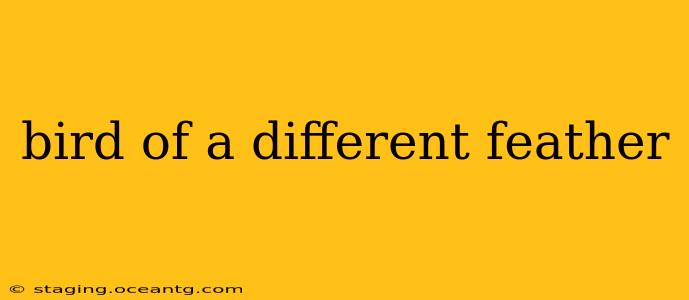The idiom "bird of a different feather" is a common phrase used to describe someone who is very different from others in a group or from the speaker. It implies a fundamental incompatibility or a lack of shared characteristics, suggesting that despite being in the same environment or context, this individual stands apart due to their unique personality, interests, or values. Understanding the nuances of this idiom, its origins, and its modern usage is key to appreciating its enduring appeal.
What Does "Bird of a Different Feather" Actually Mean?
At its core, "bird of a different feather" signifies dissimilarity. It paints a picture of a bird that doesn't quite fit in with its flock. This doesn't necessarily imply negativity; it simply highlights the individual's uniqueness. The phrase often indicates that because of these differences, the individual may struggle to connect with or understand the others in their group. This lack of common ground can lead to misunderstandings or a lack of camaraderie.
Where Did the Idiom "Bird of a Different Feather" Come From?
The idiom is a slightly altered version of a line from John Ray's 1670 book, A Collection of English Proverbs. Ray wrote, "Birds of a feather flock together," which became a well-known proverb emphasizing the tendency of similar individuals to associate with one another. The inverse, "bird of a different feather," emerged later as a way to describe those who don't conform to this pattern. It elegantly contrasts with the original proverb, highlighting the individual's distinct characteristics.
What are Some Examples of "Birds of a Different Feather"?
The beauty of this idiom lies in its flexibility. It can apply to a wide range of situations and individuals. Here are a few examples:
- A shy, introverted person in a group of extroverted friends: They may find it difficult to relate to their friends' boisterous nature and prefer quieter activities.
- An environmentally conscious individual in a family that prioritizes material possessions: Their values clash, leading to potential disagreements and strained relationships.
- A highly analytical individual in a team that thrives on creative brainstorming: While both approaches are valuable, the differences in their approach to problem-solving could create friction.
How is "Bird of a Different Feather" Used in Modern Context?
Today, the idiom remains highly relevant and is used across various social contexts. It’s often used to describe someone who is:
- Unique and unconventional: The phrase highlights their individuality and sets them apart from the norm.
- An outsider: It can suggest a feeling of being excluded or not belonging to a particular group.
- Incompatible: It emphasizes the lack of common ground between the individual and others.
Is Being a "Bird of a Different Feather" Always Negative?
No, not at all. While the idiom can sometimes imply isolation or difficulty fitting in, it doesn't inherently carry a negative connotation. Being different can be a strength, leading to innovative thinking, unique perspectives, and the potential to challenge established norms. The phrase simply acknowledges the existence of those who stand apart.
What's the Difference Between "Bird of a Different Feather" and "Odd One Out"?
Both phrases describe individuals who don't quite fit in, but there's a subtle difference. "Odd one out" often suggests a more superficial difference, perhaps in terms of appearance or a single characteristic. "Bird of a different feather" implies a more profound dissimilarity, often related to personality, values, or beliefs.
Why is "Bird of a Different Feather" Such an Enduring Idiom?
The enduring appeal of "bird of a different feather" stems from its ability to concisely capture a complex idea: the experience of being different and the challenges and opportunities that come with it. It's a relatable phrase that resonates with anyone who has ever felt like they don't quite fit in, highlighting the universal human experience of seeking connection and belonging while simultaneously celebrating individuality. Its evocative imagery and poetic quality contribute to its lasting power.
